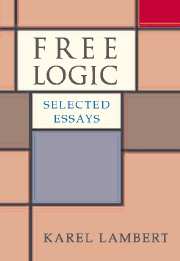Book contents
- Frontmatter
- Contents
- Introduction
- 1 Russell's Version of the Theory of Definite Descriptions
- 2 Existential Import, ‘E!’ and ‘The’
- 3 The Reduction of Two Paradoxes and the Significance Thereof
- 4 The Hilbert-Bernays Theory of Definite Descriptions
- 5 Foundations of the Hierarchy of Positive Free Definite Description Theories
- 6 Predication and Extensionality
- 7 Nonextensionality
- 8 The Philosophical Foundations of Free Logic
- 9 Logical Truth and Microphysics
1 - Russell's Version of the Theory of Definite Descriptions
Published online by Cambridge University Press: 05 June 2012
- Frontmatter
- Contents
- Introduction
- 1 Russell's Version of the Theory of Definite Descriptions
- 2 Existential Import, ‘E!’ and ‘The’
- 3 The Reduction of Two Paradoxes and the Significance Thereof
- 4 The Hilbert-Bernays Theory of Definite Descriptions
- 5 Foundations of the Hierarchy of Positive Free Definite Description Theories
- 6 Predication and Extensionality
- 7 Nonextensionality
- 8 The Philosophical Foundations of Free Logic
- 9 Logical Truth and Microphysics
Summary
INTRODUCTION
It is mildly ironic that the title of this chapter is an unfulfilled (or improper) definite description because Russell really had two versions of the theory of definite descriptions. The two versions differ in primary goals, character and philosophical strength.
The first version of Russell's theory of definite descriptions was developed in his famous essay of 1905, ‘On Denoting’. Its primary goal was to ascertain the logical form of natural language statements containing denoting phrases. The class of such statements included statements with definite descriptions, a species of denoting phrase, such as ‘The Prime Minister of England in 1904 favored retaliation’ and ‘The gold mountain is gold’. So the theory of definite descriptions contained in what Russell himself regarded as his finest philosophical essay is a theory about how to paraphrase natural language statements containing definite descriptions into an incompletely specified formal language about propositional functions. Russell used this version of his theory to disarm arguments such as Meinong's arguments for beingless objects. Such reasoning, he said, is the product of a mistaken view about the logical form of statements containing definite descriptions.
The second and later version is presented in that epic work of 1910, Principia Mathematica (hereafter usually Principia). Its primary goal. in contrast to the first version, was to provide a foundation for mathematics, indeed, to reduce all of mathematics to logic. In chapter *14 Russell introduces a special symbol, the inverted iota, and uses it to make singular term-like expressions out of quasi-statements.
- Type
- Chapter
- Information
- Free LogicSelected Essays, pp. 1 - 15Publisher: Cambridge University PressPrint publication year: 2002



